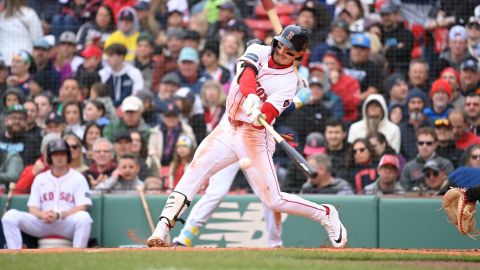BOSTON — It's the kind of ratio closers commonly put up in a single inning, but, for Aaron Cook, it's over 27 frames.
Two-to-one. That's Cook's strikeout-to-walk ratio since being recalled from Pawtucket and inserting himself into the starting rotation on June 24. And no, that's not an adjusted fraction.
In the 27 innings he's pitched over four starts, Cook has actually gotten the benefit of just two strikeouts yet yielded only a single free pass. That trend continued on Monday evening, as Cook neither walked nor struck out a batter over his seven innings of work.
"Me and [Josh Beckett] were joking that he's got a streak of 200-something games consecutive with a strikeout," said Cook after the Red Sox 5-1 win over the Chicago White Sox. "And I'm going to work on going the other direction, see if I can go 200 without getting a strikeout."
Cook has never been a flamethrower. His personal best for strikeouts came during the 2006 season with the Colorado Rockies, when he put down 92 batters over 212 2/3 innings. That itself is not a dominant rate, but compared with two over 27 innings, the younger Cook might as well have been Pedro Martinez compared with his veteran self.
It's a common refrain that when pitchers grow older and lose the ability to challenge with mid-90s heat they have to learn to pitch to contact to remain effective. Beckett has openly stated this as a goal during the 2012 season.
Cook, however, has never had the kind of live arm that generates consistent swings-and-misses. He's always been a classic sinkerball pitcher, which was one of the reasons he was able to fare better than most in the thin air of Coors Field. But Cook, too, has made adjustments as he's gotten older.
"There are a couple pitches I've been working on with [pitching coach Bob McClure]," said Cook. "There are times that lefties especially start to lean over the plate, just try to drop the ball into left field, and I started to recognize that. I have a cutter now that I can throw into them, and also have a slider to go down."
For fans watching the game at home, Cook's style can have some unintended benefits. Openly comparing himself to Mark Buehrle — the Miami Marlins starter known for his quick pace on the mound — Cook doesn't waste a lot of time between pitches. Rather, he prefers to keep himself, and his infielders, in a steady rhythm. It makes for quicker games, such as the 2:40 mark put up Monday night, but also fuels a certain energy on the diamond.
"I've joked around that I have a two-hour attention span," said Cook. "So I like to get it over with quick. That's the kind of the pace I like to work at."
For the Red Sox, the resurgence of Cook — after battling injuries the past two seasons with the Rockies — has been an incredible boon during a season when the starting rotation has struggled with consistency. So whether they be via the strikeout or a 6-3 groundout, the team will take outs however they can get them.
"Very few guys are going to get on with a free pass," when Cook's on the mound, said Red Sox manager Bobby Valentine. "He's going to pound the zone with a pitch that moves down, and try to get them to hit the top of the ball… He had a really good sinker tonight."
The Red Sox hope it continues to be good the rest of the season.



